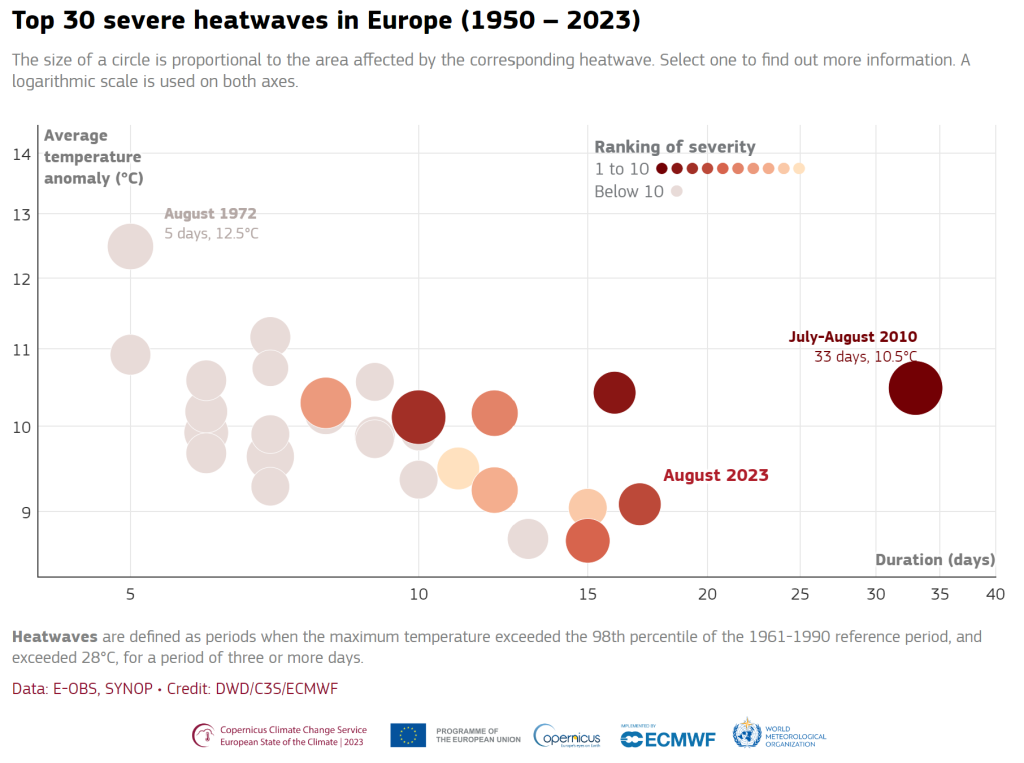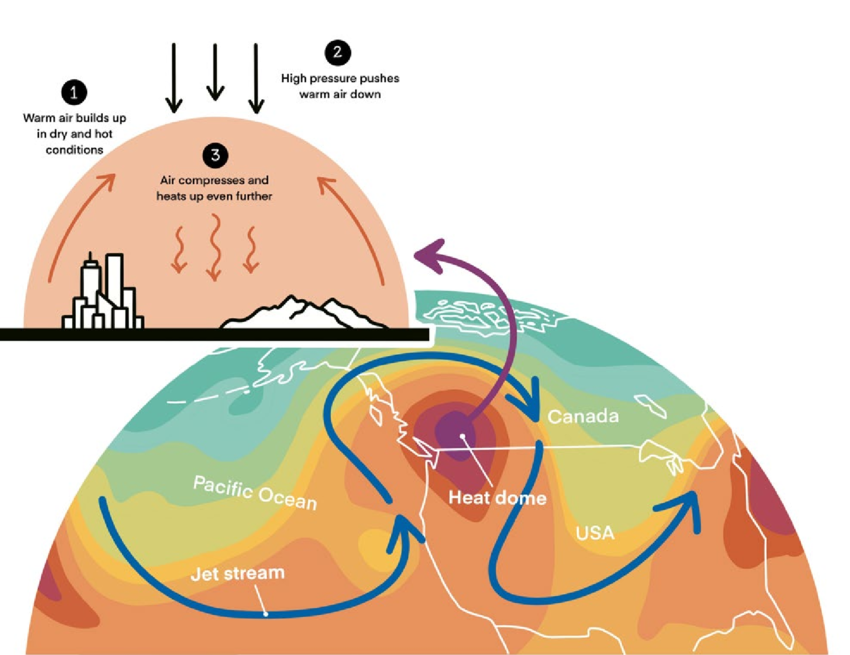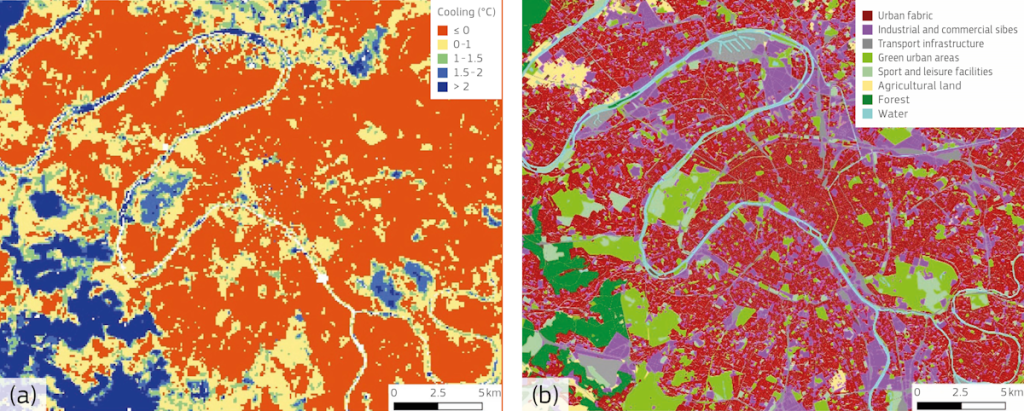Have you recently felt dizzy walking back home with your grocery bags under the blazing August sun? How many of you are struggling to sleep this summer, with noisy fans helplessly pointed at the bed? Many of you likely sought relief, whether by taking a dip in the sea or enjoying the refreshing coolness of the mountain evenings.
With June 2024 recording the highest air surface temperatures on record, and global temperatures continuing to rise, this is no coincidence. Prolonged periods of above-average heat, called heatwaves, are becoming more frequent and increasingly difficult to endure..

The 30 most severe heatwaves in Europe, 1950–2023. The size of a circle is proportional to the area affected by the corresponding heatwave. Heatwaves ranked as more severe are indicated by darker colours, and grey indicates those with a ranking of severity below 10. Source: DWD. Credit: DWD/C3S/ECMWF.
This is what defines a heatwave, according to a report from the Copernicus program: “ a prolonged period of much-warmer-than-average weather. A heatwave would typically last for several days to a few weeks, involve temperatures that are much higher than usual for the region in question, and in some regions may be accompanied by high humidity levels, which can exacerbate the effects of the heat on the human body”,
How does a heatwave form?
Heatwaves are a direct effect of human-induced climate change: with high pressure weather system (anticyclone) and cloudless weather being more and more frequent, a vicious circle forms: the warm air from the earth surface is pressed down by the anticyclone creating what is called a heat dome, where the compressed hot air is trapped and heat up even more.

How a heat dome forms, adapted from AFP, 2021 and Hills and others, 2021. Source: Eberle, Caitlyn & Higuera Roa, Oscar & Sparkes, Edward. (2022). Technical Report: British Columbia heatwave.
Heatwaves: everybody loses
Heatwaves have wide-ranging environmental and socio-economic impacts, particularly when combined with prolonged dry weather and drought. Examples of direct effects on our livelihood are on the news: rivers running dry, rationing of water resources for agriculture and increased energy demand for cooling systems. Indeed, extreme heat can deplete soil moisture, reduce river flows, and lower groundwater reserves, threatening water availability for agriculture, industry, and households. Agriculture is especially vulnerable, as heatwaves can damage crops, reduce yields, and stress livestock, leading to economic losses and higher food prices.
Urban heat islands
Urban areas have several characteristics that intensify heat according to the European Joint research Centre. For instance, cities have more sealed surfaces, like roads and buildings, which absorb heat during the day and release it at night. The high density of people and infrastructure, such as public transport systems, also generates additional heat. This is further exacerbated by poor ventilation and a lack of green spaces and waterways, which could otherwise help cool the environment.The impact of extreme heat is dangerous. Beyond causing dehydration, heatstroke, and other immediate health issues, the Urban Heat Island (UHI) effect also traps pollution, reducing air quality and leading to long-term health risks. These risks disproportionately affect vulnerable and marginalized groups, including low-income, unemployed, and homeless individuals, as well as children, the elderly, and those with chronic conditions. According to Copernicus ESOTC 2023, extreme heat has been the biggest killer among extreme weather and climate events in Europe in recent decades. During the summers of 2003, 2010, and 2022, it’s estimated that heatwaves caused between 55,000 and 72,000 deaths each year. From 2000 to 2020, heat-related deaths are believed to have risen in 94% of the European regions that were tracked. Additionally, increased energy demand during heatwaves raises electricity costs and risks power outages, while tourism and transportation systems also suffer, with fewer visitors and damaged infrastructure.
Marine heatwaves: how long can our ocean stand?
Marine ecosystems have been acting as the planet’s cooler: as temperatures continue to rise, our oceans have absorbed nearly 90% of human-induced global warming, according to NOAA Climate. This has, of course, had profound impacts on marine ecosystems. Findings from NOAA suggest that nearly 60% of all coral reefs are bleached, a phenomenon “where prolonged elevated temperatures cause corals to expel the algae they rely on for energy, often resulting in coral death.”
Changes in the abundance and distribution of marine life are also occurring, leading to shifts in the food chain and affecting the availability of fish stocks for the fishing industry. Marine heatwaves further impact sea surface temperature (SST), the primary energy source for hurricanes, potentially making them stronger. Additionally, prolonged periods of high SST could lead to an extended hurricane season.
Join the LandNet and the ResAlliance project to learn more and help make a difference for a better future in Europe!
What can we do?
Heatwaves are a direct consequence of human-induced climate change. Tackling heatwaves requires a rapid shift towards more sustainable development, accelerating the transition to renewable energy, and overcoming political inaction to reduce greenhouse gases. Adaptation and mitigation are key strategies, particularly in our cities. Urban planning should incorporate adaptation measures such as green and blue spaces, green roofs, and energy efficiency buildings. Nature based solutions offer a strong framework for improving and adapting strategies to reduce the impact of heatwaves, and many European cities have already begun integrating more green and blue spaces.

image (a) shows the cooling effects of green spaces when compared to other land surfaces in the city of Paris (b) (Marando et al., 2022)
To reduce health impacts, many other implementations could be adopted: accessibility to water and public health initiatives for early warning systems, public education campaigns, cooling centers and heat action plans.
A strategy toward resilient landscapes, particularly agricultural and forests, is of key importance in mitigating the impact of heatwaves. Finding solutions, adaptation and mitigation strategies to reduce extreme events such as droughts and wildfires, stands at the core of the ResAlliance project: find out more on our project and goals, visit: https://www.resalliance.eu/